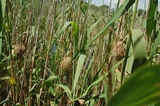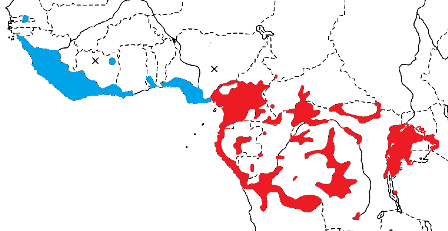Weaver species
Choose different species from drop-down list and press 'Go' button. See Full species list.Vieillot's Black Weaver Ploceus nigerrimus
IUCN: Least concern Discovery: 028Categories: black, acacias, fruit, waterbirds, nectar, pest, palm,
News items about species
Discovery
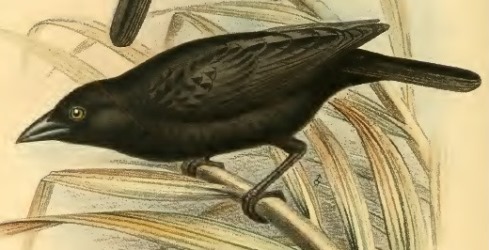
figure from Bartlett 1888 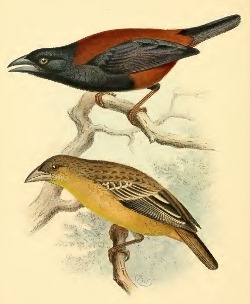
figure from Bartlett 1888 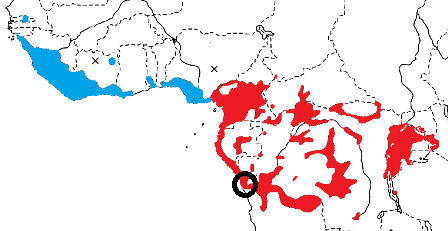
distribution, type locality circled IntroductionThe Vieillot's Black Weaver was formally described by Louis Jean Pierre Vieillot, a French ornithologist. The birds had been collected by Jean Perrein, a French naturalist, who travelled in West Africa and other localities. Vieillot was interested in the habits of living birds, but Perrein did not seem to provide any field notes for the Vieillot's Black Weaver, as he had done for the Crested Malimbe.Vieillot mentioned that this weaver had been collected at Congo et Caconga, one of three historic provinces in Cabinda, Angola. Perrein returned to France after a long stay in Cabinda, in about 1800. Perrein sent his specimens to Academy of Sciences in Bordeaux, France, from where the Vieillot's Black Weaver type was probably moved to the Paris Museum. Many early authors referred to the Vieillot's Black Weaver and more specimens of this common weaver were collected in West Africa, but it was only illustrated in 1888 for the first time. Bartlett (1888) illustrated both subspecies. Scientific citationPloceus nigerrimus Vieillot 1819 Nouv. Dict. Hist. Nat., nouv. ed., 34:130 "Kingdom of Congo", Cabinda.Meaning of namesnigerrimus Latin: very black (super. of niger, black).First English nameThe chestnut-fusous Weawer (Reichenbach 1863) [originally given as Black and chestnut Weaver-bird (Burton 1883)].Alternate namesChestnut and Black Weaver, Vieillot's Weaver.CollectorJean Perrein.Date collectedBefore 1800, when Perrein returned to France with his specimens.Locality collectedCongo et Caconga, ie. Cabinda, Angola.Type specimensType specimen is probably in the Paris Museum. |
The above is based on Weaver Wednesday 2, a weekly series about the discovery of each weaver species.
This species text first appeared as
Weaver Wednesday [145] - Discovery [28]: Vieillot's Black Weaver on 2015-03-25
1. Basic biology

western subspecies 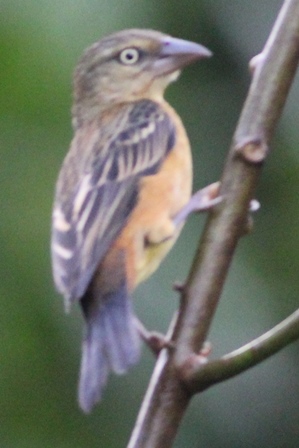
female, from Birdpix (by M. Booysen) 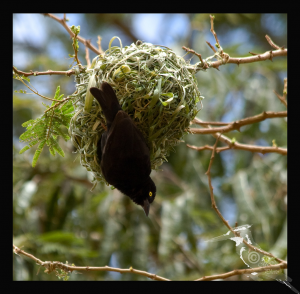
eastern subspecies Identification. The Vieillot's Black Weaver Ploceus nigerrimus is named after its black colour. The adult male is wholly black (nominate race, photo above right) or black with chestnut back, rump and belly (P. n. castaneofuscus, photo above left). The yellow eye distinguishes it from other black weavers - Maxwell's Black Weaver has a whitish eye, and the female Cassin's Malimbe has a dark eye. The female and juvenile Vieillot's Black Weaver are olive with a little yellow on below and streaks on the back, and the eye is pale.
Distribution.
Two subspecies of the Vieillot's Black Weaver are recognised (see map left, based on Birds of Africa):
Habitat. The Vieillot's Black Weaver inhabits forest clearings, often in villages, wooded areas and high grass savannas, although not found in forest. Food. The Vieillot's Black Weaver feeds on mainly insects (grasshoppers, winged ants, winged termites, caterpillars and butterflies); also seeds, fruit, berries and nectar. Birds move far from their colonies to forage in savanna and gallery forest. They regularly join mixed-species flocks of insectivores foraging in more open forest areas. Nigerian birds search areas where squirrels Funisciurus anerythrus have been feeding, and collect the outer fibrous layers of oil palm nuts which the squirrels discard. Breeding. The Vieillot's Black Weaver is colonial (photo left, from phown 4209), gregarious, territorial, and polygynous, with up to 5 females in a males' territory. Breeding activity seems to coincide with rainfall.
Colonies occur in trees, reeds, bulrushes, papyrus (photo right, from phown 871), or bamboos. There may be several nests in the territory of one male, which may be part of a colony of dozens or hundreds of nesting weavers.
A particularly interesting PHOWN record is of a young python resting on the nest of a Vieillot's Black Weaver (photo left, from phown 2448). |
The above is based on Weaver Wednesday, a weekly series about weaver species.
This species text first appeared as
Weaver Wednesday [27]: Vieillot's Black Weaver on 2012-12-19
2. Breeding facts
| Pair bond Polygynous, with up to five females in one male territory Breeding season Jan in Gambia, Feb in Guinea, Feb-Apr and Aug-Nov in Liberia, Jan-Jul in Ghana, Feb and Sept-Oct in Togo, May-Aug in Nigeria, in all months except Aug in Cameroon, Dec-Feb, Apr and Jul in Gabon, Jul-Aug in Central African Republic, Nov-Feb and Sept in PRCongo; in DRCongo, Nov in S, Apr and Aug-Sept in savanna, Jul-Feb in Lukolela, and probably all year (confirmed in Feb, Jul-Aug and Nov) in ltombwe; Aug and Nov in Sudan, throughout year (peaks Feb-May and Sept-Oct) in Uganda, Jul-Sept in Kenya and Oct-Mar in Angola Nest site placed in bulrushes (Typha), tall elephant grass, palm, bamboo or tree, 1-2 m above water or, when in tree, 6-8 m above ground Nest building woven by male Colony size Colonial, similar number of nests (maximum three) per territory in colonies of different densities, but mean distance between nests variable, 27-52 cm Clutch size 2 eggs Egg colour pale blue, rarely with a few purple spots at thick end Egg size average size of 40 eggs 23.9 x 16.1 mm (Cameroon) Incubation incubation by female only, no information on duration of incubation period Chicks and nestling period chicks fed primarily by female, male may contribute late in season as breeding activity declines; no information on duration of nestling period |
Breeding information based on Handbook of the Birds of the World, Vol. 15.
3. Photos of Weaver Nests
 Vm 29938 |  Vm 28365 |  Vm 28245 |  Vm 27827 |  Vm 26364 |  Vm 18153 |
Thumb-nails of most recent PHOWN records - click on one to see its full record
See all PHOWN records for this species here.
PHOWN (Photos of Weaver Nests) provides valuable info on breeding distribution and colony sizes of weavers.
You can contribute by registering and submitting photos at Virtual Museum webpage.
4. Breeding distribution
Google map showing distribution (For species with small ranges you need to zoom in at the correct area to see the range):
yellow blob - range of weaver species; read more about this here.
![]() - PHOWN records with photos
- PHOWN records with photos
![]() - PHOWN records with no photos (Nest Record Cards, other records)
- PHOWN records with no photos (Nest Record Cards, other records)
![]() - Birdpix records
- Birdpix records
![]() - comments on out of range records, or interesting records
- comments on out of range records, or interesting records
![]() - type locality
- type locality
CLICK on the marker on the map to see individual record details.
5. Range changes
Not South African speciesThe above is based on Weaver Wednesday 3, a weekly series about range changes in South African weaver species.
This species text first appeared as
n/a








